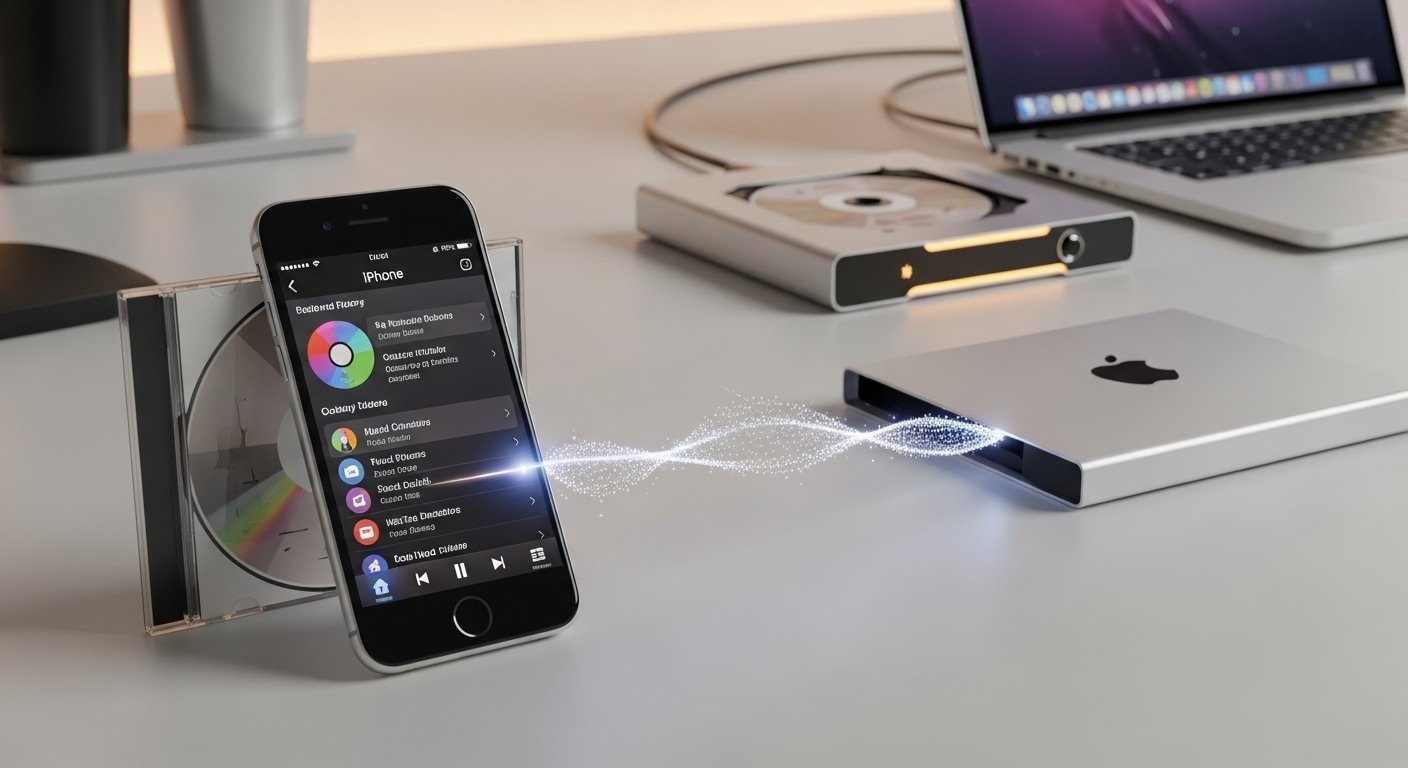Remember that stack of CDs gathering dust in your closet? Those albums you bought at midnight releases, rare concert recordings, or special editions that never made it to streaming platforms hold more than just music—they hold memories. The cdiphone concept emerged from a simple need: bridging the gap between physical compact discs and Apple’s modern iPhone ecosystem. While streaming dominates today’s music landscape, millions of music enthusiasts still seek ways to enjoy their treasured CD collections on their iPhones without repurchasing everything digitally.
This comprehensive guide reveals everything about cdiphone—from understanding what it means to practical, step-by-step methods for transferring your entire CD library to your iPhone.
Explore More Topic: Anonposted
Understanding What CDiPhone Really Means
The term cdiphone isn’t an official Apple product or registered trademark. Instead, it’s a community-created mashup of “CD” (compact disc) and “iPhone” that describes various tools, methods, and workflows for connecting these two technologies. Think of cdiphone as the umbrella concept covering everything from external CD drive adapters to software solutions that make CD-to-iPhone transfers possible.
This terminology gained traction in tech forums, music collector communities, and among audiophiles who refuse to let their physical media collections become obsolete. The cdiphone movement represents more than nostalgia—it’s about preserving audio quality, maintaining ownership of your music, and accessing rare recordings unavailable on Spotify or Apple Music.
The Technology Behind CDiPhone Concepts
At its core, cdiphone technology involves three main approaches: physical hardware adapters that connect CD drives to iPhones, software applications that facilitate music transfer, and cloud-based systems that stream ripped CD content. Each method serves different user needs, from audiophiles demanding lossless audio quality to casual listeners seeking simple solutions.
Why Music Lovers Are Searching for CDiPhone Solutions
The resurgence of interest in physical media isn’t just nostalgia—it’s driven by practical concerns that streaming services can’t always address. Here’s why thousands search for cdiphone solutions monthly:
Superior audio quality tops the list, as CDs offer uncompressed sound that surpasses most streaming formats. While Spotify uses 320 kbps compression, CDs deliver true lossless audio at 1,411 kbps. For serious listeners using high-quality headphones, this difference is immediately noticeable.
Ownership and permanence matter to collectors who’ve watched albums disappear from streaming platforms due to licensing disputes. Your physical CDs can’t be removed from your library by a corporate decision. Additionally, many live recordings, regional releases, and limited editions simply never made it to digital platforms.
Cost savings provide another compelling reason—why repurchase music you already own? If you’ve accumulated hundreds of CDs over decades, buying digital copies would cost thousands of dollars. The cdiphone approach lets you digitize what you already have for free.
Can You Actually Connect a CD Drive to Your iPhone?
This question generates considerable confusion, so let’s clarify the technical reality. Physically connecting an external CD drive to an iPhone is theoretically possible but impractical for most users. Here’s what you’d need: Apple’s Lightning to USB 3 Camera Adapter (or USB-C adapter for iPhone 15 and newer), a powered USB hub to supply sufficient energy, and an external USB CD/DVD drive.
However, critical limitations make this approach frustrating. iOS doesn’t natively support CD file systems like ISO 9660 or UDF, meaning your iPhone won’t recognize the disc even when connected. You can’t simply pop in a CD and hit play—iOS lacks the software to read audio CD data directly. Additionally, CD drives require more power than an iPhone can supply without an external power source.
The Practical Alternative Everyone Actually Uses
The industry-standard cdiphone method involves ripping CDs on a computer first, then transferring the digital files to your iPhone. This approach is reliable, legal, and officially supported by Apple. While it adds an extra step, it provides complete control over audio quality, file organization, and metadata editing.
Step-by-Step Guide: Transferring CD Music to Your iPhone
Let’s walk through the proven process that thousands of users rely on for their cdiphone setup. This method works for both Windows and Mac users and ensures the best audio quality.
Phase 1: Ripping Your CDs to Computer
First, you’ll need CD ripping software. iTunes (on Windows or macOS Mojave and earlier) includes built-in CD ripping functionality. For macOS Catalina and newer, use the Apple Music app. Advanced users often prefer specialized software like Exact Audio Copy for Windows or XLD for Mac, which offer more control over audio quality settings.
Insert your CD into your computer’s optical drive. The software should automatically recognize it and fetch album information from online databases like Gracenote. Select your preferred audio format—we’ll discuss format choices in detail shortly. Start the ripping process, which typically takes 5-10 minutes per disc depending on your drive speed and chosen format.
Phase 2: Importing to Your Music Library
Once ripped, import the files into iTunes or Apple Music by dragging them into your library or using the “Add to Library” function. The software will organize them by artist, album, and genre automatically. Take a moment to verify that album artwork and metadata imported correctly—you can manually edit any incorrect information.
Phase 3: Syncing with Your iPhone
Connect your iPhone to your computer using a USB cable or enable Wi-Fi sync if you’ve set it up previously. In iTunes or Finder (on macOS Catalina and later), select your iPhone from the device list. Navigate to the “Music” tab and choose which albums, artists, or playlists you want to sync. Click “Apply” or “Sync” and wait for the transfer to complete.
Choosing the Best Audio Format for Your CDiPhone Setup
Your format choice significantly impacts both audio quality and iPhone storage consumption. Here’s what you need to know about each option for your cdiphone library:
ALAC (Apple Lossless Audio Codec) preserves 100% of the original CD quality without any compression. A typical album requires about 300-400 MB in ALAC format. This format integrates perfectly with Apple’s ecosystem and maintains bit-perfect audio. Choose ALAC if you’re an audiophile with ample iPhone storage (256 GB or more).
AAC (Advanced Audio Codec) is Apple’s preferred compressed format, offering excellent quality at moderate file sizes. At 256 kbps, AAC provides quality nearly indistinguishable from the original CD for most listeners while using about 60-80 MB per album. This format works seamlessly across all Apple devices.
MP3 remains universally compatible and space-efficient. At 320 kbps (the highest MP3 quality), you’ll use roughly 80-100 MB per album. While MP3 quality is good, AAC typically sounds better at the same bitrate.
FLAC offers lossless quality like ALAC but wasn’t officially supported by iOS until recently. If you already have FLAC files from other sources, newer iPhones can play them through third-party apps.
Best Third-Party Apps for CDiPhone Music Playback
If you’d rather skip iTunes entirely, several excellent iOS apps support playing ripped CD tracks while offering features Apple’s native app doesn’t provide.
VLC Media Player for iOS handles virtually any audio format imaginable, including rare formats that iTunes won’t touch. It supports Wi-Fi transfer, allowing you to upload music from your computer without cables. VLC also includes an equalizer and playback speed controls.
Documents by Readdle functions as both a file manager and media player. Its built-in audio player supports playlists and folder organization. The app excels at importing files from various sources including cloud storage.
Foobar2000 Mobile brings the legendary audiophile desktop player to iOS. It supports advanced formats, gapless playback, and comprehensive tagging. This app is perfect for serious listeners who care about audio quality and organization.
Cloud-Based CDiPhone Solutions for Streaming Anywhere
Modern cdiphone setups often incorporate cloud storage, letting you stream your CD collection without consuming iPhone storage. Upload your ripped music to Google Drive, Dropbox, or iCloud Drive, then access it through their respective iOS apps. This approach works brilliantly if you have a large collection that won’t fit on your device.
Plex Media Server represents the premium option for streaming your personal music library. Install Plex on your computer, point it to your ripped CD folder, and stream everything to your iPhone from anywhere with internet access. Plex automatically fetches album artwork, lyrics, and artist information, creating a professional streaming experience from your personal collection.
The cloud approach requires reliable internet connectivity and may use cellular data when you’re away from Wi-Fi. However, most cloud music apps allow downloading specific albums for offline listening.
Common CDiPhone Setup Mistakes to Avoid
Even experienced users make these mistakes when setting up their cdiphone system. First, attempting to connect CD drives directly to iPhones without understanding iOS limitations leads to frustration and wasted money on incompatible adapters. Always rip CDs on a computer first.
Second, choosing the wrong audio format can cause regret later. Ripping everything to low-bitrate MP3 (128 kbps or lower) permanently degrades your audio quality. Since you’re only ripping each CD once, use at least 256 kbps AAC or higher.
Third, neglecting backup creates risk. After spending hours ripping CDs, store your digital library on an external hard drive or cloud backup service. Losing your digital collection means repeating the entire process.
Finally, ignoring metadata management leads to messy, unsearchable libraries. Take time to ensure artist names, album titles, and track information are correct before syncing to your iPhone.
Legal Considerations for Your CDiPhone Setup
Ripping your own CDs for personal use falls under fair use in most countries, making the cdiphone process completely legal. You own the physical media and have the right to create backup copies for personal listening. However, distributing or selling ripped CD files violates copyright law. Your cdiphone library should remain for your personal enjoyment only.
The Future of CDiPhone Technology
As vinyl records have experienced a remarkable comeback, CDs may follow suit. Audiophiles increasingly recognize that physical media offers superior sound quality compared to streaming compression. The cdiphone community continues growing as more people rediscover their CD collections.
Potential future developments might include official Apple accessories for CD connectivity, improved iOS support for CD file systems, or dedicated cdiphone apps that streamline the entire process. Until then, the computer-based ripping method remains the gold standard.
Alternatives Worth Considering
If the cdiphone approach seems too complex, several alternatives exist. Apple Music’s subscription service offers over 100 million songs with high-quality audio streaming. However, you’ll pay monthly fees indefinitely and won’t have permanent ownership.
Professional CD ripping services will digitize your collection for a fee, typically charging per disc. This option saves time but costs money. For small collections, purchasing digital albums might prove more convenient than ripping CDs yourself.
Explore More Topic: 5StarsStocks.com
Frequently Asked Questions About CDiPhone
Q: Can I play CDs directly on my iPhone without a computer?
No, iPhones cannot play CDs directly even with adapters due to iOS limitations. You must first rip CDs to digital files on a computer, then transfer those files to your iPhone. This process preserves audio quality while making your music portable.
Q: What’s the best audio format for cdiphone setups?
ALAC (Apple Lossless) offers the best quality by preserving CD audio perfectly, but requires significant storage space. For most users, 256 kbps AAC provides excellent quality at reasonable file sizes, making it the optimal balance for cdiphone libraries. Choose based on your iPhone’s storage capacity and audio quality preferences.
Q: Is ripping my CDs to iPhone legal?
Yes, ripping CDs you own for personal use is legal under fair use provisions in most countries. The cdiphone process of creating digital backups for personal listening is widely accepted. However, sharing or distributing these files violates copyright law.
Q: How much storage do I need on my iPhone for a large CD collection?
A typical CD album uses 300-400 MB in lossless ALAC format or 60-100 MB in compressed AAC/MP3 format. For 100 albums, you’d need 30-40 GB (lossless) or 6-10 GB (compressed). Cloud-based cdiphone solutions eliminate storage concerns by streaming your collection.

